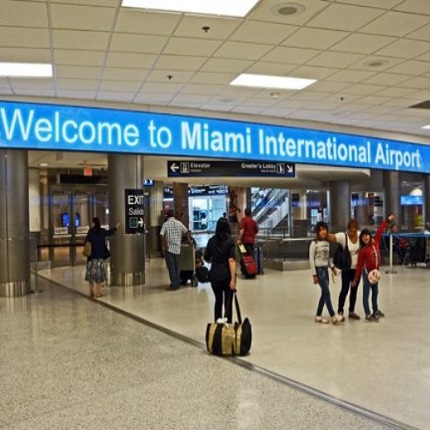 Miami continues to outdo itself as a magnet for travelers, drawing in a record number of 15.5 million visitors last year, the Greater Miami Convention & Visitors Bureau said at its annual State of the Travel and Tourism Industry breakfast Friday.
Miami continues to outdo itself as a magnet for travelers, drawing in a record number of 15.5 million visitors last year, the Greater Miami Convention & Visitors Bureau said at its annual State of the Travel and Tourism Industry breakfast Friday.
With the Miami skyline serving as a not-so-subtle backdrop at Key Biscayne’s Rusty Pelican restaurant, bureau president and CEO William D. Talbert III touted another year of records for Miami in 2015, with 6.4 percent growth in visitorship over 2014’s record year. Of the 1 million additional visitors this year, about 500,000 traveled to Miami for the first time.
“Look outside the window, it ain’t all bad,” Talbert told about 400 guests, most from the hospitality industry. “Another record year.”
Domestic visitors made up slightly more than half of Miami’s tourists, and international tourists, primarily from Europe and the Caribbean, accounted for the other half.

Of the domestic visitors, the largest market of origin was the New York City region, with 2.1 million travelers, up 10.5 percent over last year, followed by Chicago, Philadelphia, Boston and Atlanta. This year, New York visitors accounted for an economic impact of $2.3 billion, making it the first market to break the $2 billion mark.
Internationally, Brazil and Colombia remain billion-dollar markets as well, despite less robust growth from international visitors overall.
In 2015, the number of international travelers grew by only 3.4 percent, compared to domestic travelers’ 9.4 percent. But despite an economic slowdown in Latin America, Brazil remains Miami’s top international market, accounting for 747,542 travelers in 2015, up 2 percent over the previous year. The increase follows a dip in 2014, when 3 percent fewer Brazilians traveled to Miami compared to 2013.
Canada, Colombia, Argentina and Germany take the next four spots among Miami’s top international markets. The only international group that declined were Venezuelans, with 10 percent fewer travelers visiting Miami.
“We are having some challenges on the international side,” Talbert said. “Over time we’ve seen this, some go up, some go down, but Brazil is still definitely in transition.”
Talbert said the bureau will continue to monitor Brazil in 2016, but it’s too early to tell whether economic softness in South America will catch up to Miami’s hospitality industry this year, at least.
Together, the 15.5 million 2015 travelers spent $24.4 billion, up 2.3 percent from last year, according to the bureau’s latest statistics. But, on average, visitors spent 3.9 percent less per person per visit than in 2014.
Hotel occupancy rose slightly to 78.1 percent in 2015, placing Miami sixth in the nation among the top 25 hotel markets. Booking a stay at a Miami hotel cost an average of $195.75 a night in 2015, up $11 from 2014. In 2016, those numbers may be less robust as several hotels go through ownership changes and renovations.

“At the end of the day you’ve got in the pipeline thousands of hotel rooms — that creates a challenge for us to get those additional customers,” Talbert said. “But we are going to go through a period now of settling out as the new properties coming online.”
Among those: Melia Hotels International’s ME Miami opening on Biscayne Boulevard this summer; Swire Properties’ EAST, Miami opening in Brickell May 31; and Chilean Atton Brickell Miami opening this summer.
A record 136,100 people were employed in the leisure and hospitality industry in 2015, according to the bureau’s research — but several hundred will be out of jobs in 2016. Change of hands at various hotels and renovations will displace 538 workers, who will be laid off by the end of June this year, the highest number since 2009, according to records from the Florida Department of Economic Opportunity.
Looking forward, one more element may shake up Miami’s hotel industry even further this year: home-sharing network Airbnb. At Friday’s breakfast, a low grumble was felt through the room at the mention of it.
“It is a disruptor,” Talbert said. “It is the largest hotelier in the world today, it’s here and I know the city of Miami Beach is taking a look at that.”
Source: Miami Herald

